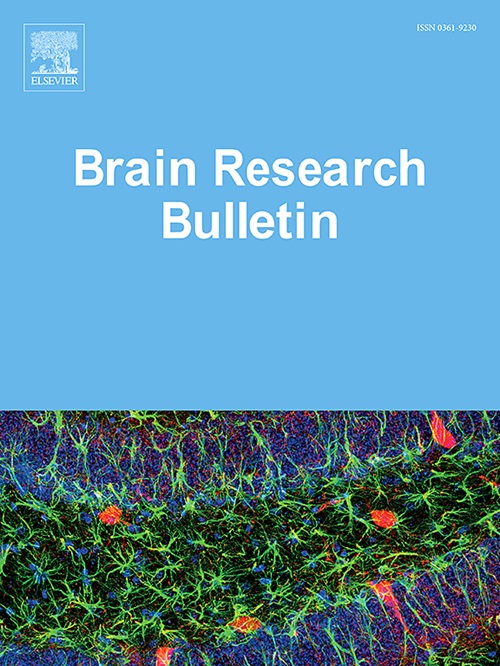一周龄新生儿对母语与非母语和非言语声音的感知:一项fNIRS研究
IF 3.7
3区 医学
Q2 NEUROSCIENCES
引用次数: 0
摘要
婴儿的语音和非语音感知能力对未来的语言学习至关重要。以往的研究主要集中在婴幼儿语言感知过程中大脑皮层的变化,而对非语言感知过程中大脑皮层的变化了解甚少。目的利用功能近红外光谱(fNIRS)研究不同语言和非语言刺激下足月健康新生儿大脑皮层的激活模式及其差异。方法采用分组设计,将36名健康的足月新生儿(7.4 ± 6.0天)暴露于两种语言刺激(母语普通话和非母语西班牙语)和三种非语言刺激(音乐、猫叫和噪音)中。使用fNIRS(54个通道)监测8个感兴趣脑区(roi)的脑活动:额极区(FPA)、额中回(MFG)、初级感觉运动皮层、颞中回(MTG)、颞上回(STG)、梭状回(FFG)、韦尼克区和布罗卡区。结果普通话刺激可激活新生儿所有roi。与西班牙语相比,普通话暴露期间FPA、MFG、STG、MTG、FFG、Wernicke区和Broca区氧合血红蛋白浓度的变化显著高于西班牙语(p <; 0.05)。与猫叫(p = 0.005)、音乐(p = 0.040)和噪音(p <; 0.001)相比,汉语暴露期间MTG的激活显著增加。同样,与西班牙语和噪音刺激相比,MFG和Broca区在音乐刺激中表现出更大的激活(p <; 0.05)。新生儿的大脑可以感知各种语言和非语言刺激,表现出对母语刺激的偏好,其次是音乐。感知非母语语言、动物叫声和噪音的能力似乎更有限。这些发现可以为今后婴幼儿语言发展的研究提供一定的参考。本文章由计算机程序翻译,如有差异,请以英文原文为准。
Perception of native vs. non-native language and non-speech sounds in one-week-old neonates: An fNIRS study
Background
Early infant phonological and non-phonological perceptual abilities are crucial for future language learning. Previous studies have focused on the changes in the cerebral cortex of infants and toddlers during speech perception, while the changes in the cerebral cortex during non-speech perception remain poorly understood.
Objective
This study aimed to investigate cortical activation patterns and differences in full-term healthy newborns under different speech and non-speech stimuli by functional near-infrared spectroscopy (fNIRS).
Methods
The cohort included 36 full-term healthy neonates (7.4 ± 6.0 days) exposed to two types of speech stimuli (native Mandarin and non-native Spanish) and three non-speech stimuli (music, cat calls, and noise) in a block design. Brain activity was monitored across eight brain regions of interest (ROIs) were monitored using fNIRS (54 channels): frontal pole area (FPA), middle frontal gyrus (MFG), primary sensorimotor cortex, middle temporal gyrus (MTG), superior temporal gyrus (STG), fusiform gyrus (FFG), Wernicke's area, and Broca's area.
Results
Mandarin stimulation activated all ROIs in newborns. Changes in oxygenated hemoglobin concentrations in FPA, MFG, STG, MTG, FFG, Wernicke's area, and Broca's area were significantly higher during Mandarin exposure compared to Spanish (p < 0.05). MTG activation was significantly greater during Mandarin exposure compared to cat calls (p = 0.005), music (p = 0.040), and noise (p < 0.001). Similarly, MFG and Broca's area showed significantly greater activation during music exposure compared to Spanish and noise stimuli (p < 0.05).
Conclusions
The newborn brain can perceive various speech and non-speech stimuli, demonstrating a preference for native language stimuli, followed by music. The ability to perceive non-native languages, animal calls, and noise appears more limited. These findings could provide some references for future research on infant and toddler language development.
求助全文
通过发布文献求助,成功后即可免费获取论文全文。
去求助
来源期刊

Brain Research Bulletin
医学-神经科学
CiteScore
6.90
自引率
2.60%
发文量
253
审稿时长
67 days
期刊介绍:
The Brain Research Bulletin (BRB) aims to publish novel work that advances our knowledge of molecular and cellular mechanisms that underlie neural network properties associated with behavior, cognition and other brain functions during neurodevelopment and in the adult. Although clinical research is out of the Journal''s scope, the BRB also aims to publish translation research that provides insight into biological mechanisms and processes associated with neurodegeneration mechanisms, neurological diseases and neuropsychiatric disorders. The Journal is especially interested in research using novel methodologies, such as optogenetics, multielectrode array recordings and life imaging in wild-type and genetically-modified animal models, with the goal to advance our understanding of how neurons, glia and networks function in vivo.
 求助内容:
求助内容: 应助结果提醒方式:
应助结果提醒方式:


